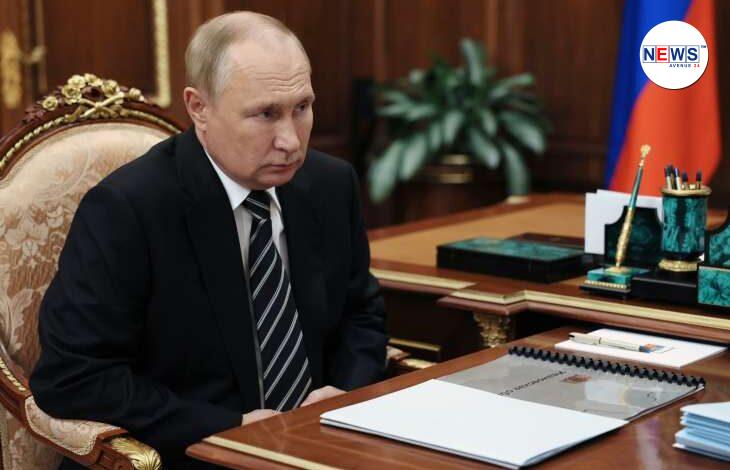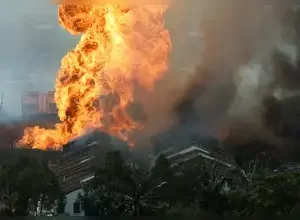
Russia Ukraine War: Putin signs laws annexing 4 Ukrainian region
Russia Ukraine War: Earlier this week, both houses of the Russian parliament ratified treaties making the Donetsk, Luhansk, Kherson and Zaporizhzhia regions part of Russia.
The formalities followed Kremlin-orchestrated “referendums” in the four regions that Ukraine and the West have rejected as a sham.
Russia Ukraine War: Russian President Vladimir Putin on Wednesday signed laws absorbing four Ukrainian regions into Russia, a move that finalises the annexation carried out in defiance of international law.
Earlier this week, both houses of the Russian parliament ratified treaties making the Donetsk, Luhansk, Kherson and Zaporizhzhia regions part of Russia
The formalities followed Kremlin-orchestrated “referendums” in the four regions that Ukraine and the West have rejected as a sham.
Will President Vladimir Putin pull the nuclear trigger if tension with the West escalates?
For Kremlin watchers trying to figure out whether the Russian leader’s nuclear threats are just bluffs, there is no more pressing — or tough — question. For now, analysts cautiously suggest that the risk of Putin using the world’s biggest nuclear arsenal still seems low. The CIA says it hasn’t seen signs of an imminent Russian nuclear attack.
Still, his vows to use “ all the means at our disposal ” to defend Russia as he wages war in Ukraine are being taken very seriously.
And his claim on Friday that the United States “created a precedent” by dropping atomic bombs in World War II further cranked up the nuclear stakes.
The White House has warned of “catastrophic consequences for Russia” if Putin goes nuclear. But whether that will stay Putin’s hand is anyone’s guess. Nervous Kremlin watchers acknowledge they can’t be sure what he is thinking or even if he’s rational and well-informed.
The former KGB agent has demonstrated an appetite for risk and brinkmanship. It’s hard, even for Western intelligence agencies with spy satellites, to tell if Putin is bluffing or truly intent on breaking the nuclear taboo.
“We don’t see any practical evidence today in the US intelligence community that he’s moving closer to actual use, that there’s an imminent threat of using tactical nuclear weapons,” CIA Director William Burns told CBS News.
“What we have to do is take it very seriously, watch for signs of actual preparations,” Burns said. Kremlin watchers are scratching their heads in part because they don’t see how nuclear force could greatly help reverse Russia’s military losses in Ukraine.
Ukrainian troops aren’t using large concentrations of tanks to wrest back ground, and combat is sometimes for places as small as villages.
So what could Russian nuclear forces aim for with winning effect?
“Nuclear weapons are not a magic wand,” said Andrey Baklitskiy, a senior researcher at the UN’s Institute for Disarmament Research, who specialises in nuclear risk.
“They are not something that you just employ and they solve all your problems. “Analysts hope the taboo that surrounds nuclear weapons is a disincentive. The horrific scale of human suffering in Hiroshima and Nagasaki after the US destroyed the Japanese cities with atomic bombs on August 6 and August 9, 1945, was a powerful argument against a repeat use of such weapons.
The attacks killed 210,000 people. No country has since used a nuclear weapon. Analysts guess that even Putin may find it difficult to become the first world leader since US President Harry Truman to rain down nuclear fire. “It is still a taboo in Russia to cross that threshold,” said Dara Massicot, a senior policy researcher at RAND Corp.
and a former analyst of Russian military capabilities at the US Defense Department. “One of the biggest decisions in the history of Earth,” Baklitskiy said.
The backlash could turn Putin into a global pariah. “Breaking the nuclear taboo would impose, at a minimum, complete diplomatic and economic isolation on Russia,” said Sidharth Kaushal, a researcher with the Royal United Services Institute in London that specializes in defense and security.
Long-range nuclear weapons that Russia could use in a direct conflict with the United States are battle-ready. But its stocks of warheads for shorter ranges — so-called tactical weapons that Putin might be tempted to use in Ukraine — are not, analysts say.
“All those weapons are in storage,” said Pavel Podvig, another senior researcher who specializes in nuclear weapons at the UN’s disarmament think tank in Geneva.
“You need to take them out of the bunker, load them on trucks,” and then marry them with missiles or other delivery systems, he said.
Russia hasn’t released a full inventory of its tactical nuclear weapons and their capabilities. Putin could order that a smaller one be surreptitiously readied and teed up for surprise use. But overtly removing weapons from storage is also a tactic Putin could employ to raise pressure without using them. He’d expect US satellites to spot the activity and perhaps hope that baring his nuclear teeth might scare Western powers into dialing back support for Ukraine.
“That’s very much what the Russians would be gambling on, that each escalation provides the other side with both a threat but (also) an offramp to negotiate with Russia,” Kaushal said.
He added: ”There is a sort of grammar to nuclear signalling and brinksmanship, and a logic to it which is more than just, you know, one madman one day decides to go through with this sort of thing.”
Analysts also expect other escalations first, including ramped-up Russian strikes in Ukraine using non-nuclear weapons.
“I don’t think there will be a bolt out of the blue,” said Nikolai Sokov, who took part in arms control negotiations when he worked for Russia’s Foreign Ministry and is now with the Vienna Center for Disarmament and Non-Proliferation.
Analysts also struggle to identify battlefield targets that would be worth the huge price Putin would pay.
If one nuclear strike didn’t stop Ukrainian advances, would he then attack again and again?
Podvig noted the war does not have “large concentrations of troops” to target. Striking cities, in hopes of shocking Ukraine into surrender, would be an awful alternative.
“The decision to kill tens and hundreds of thousands of people in cold blood, that’s a tough decision,” he said.
“As it should be.” Putin might be hoping that threats alone will slow Western weapon supplies to Ukraine and buy time to train 300,000 additional troops he’s mobilizing, triggering protests and an exodus of service-aged men.
But if Ukraine continues to roll back the invasion and Putin finds himself unable to hold what he has taken, analysts fear a growing risk of him deciding that his non-nuclear options are running out.
“Putin is really eliminating a lot of bridges behind him right now, with mobilization, with annexing new territories,” said RAND’s Massicot.
“It suggests that he is all-in on winning this on his terms,” she added. “I am very concerned about where that ultimately takes us — to include, at the end, a kind of a nuclear decision.”
Source:- INDIA TV





